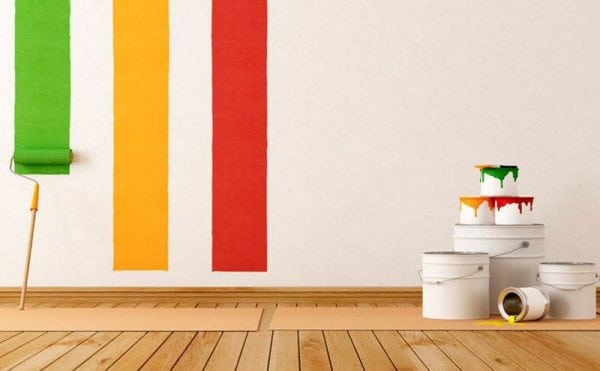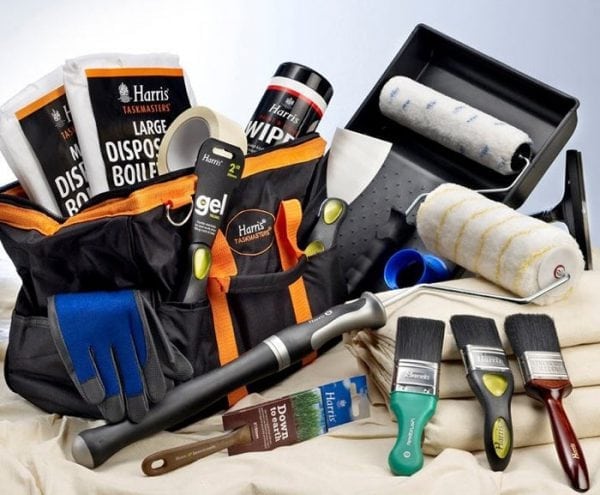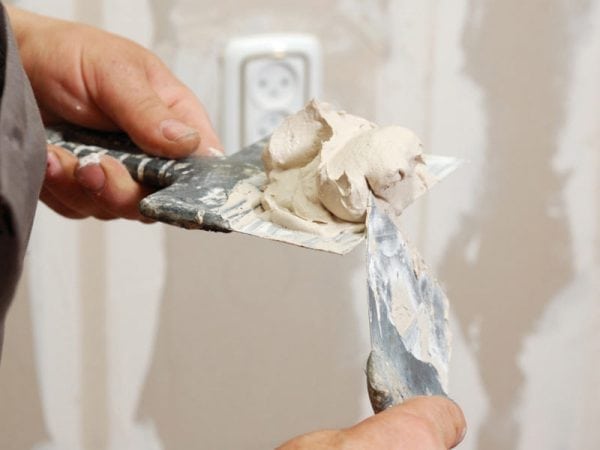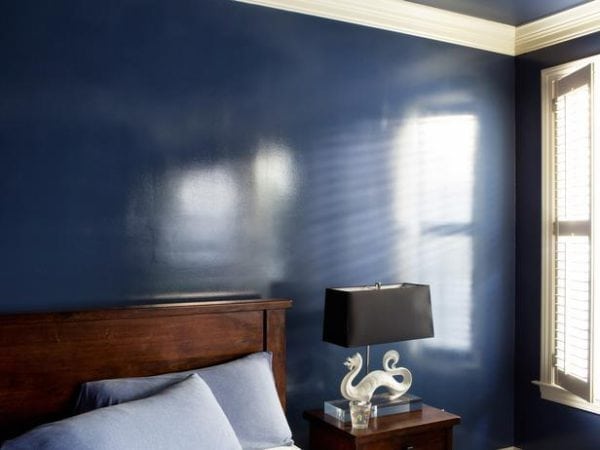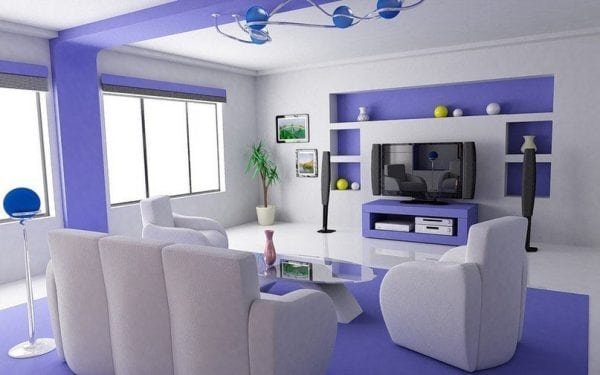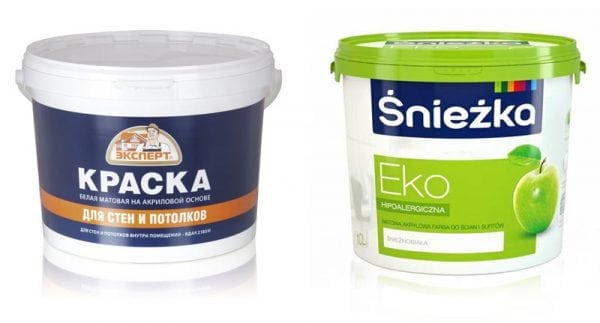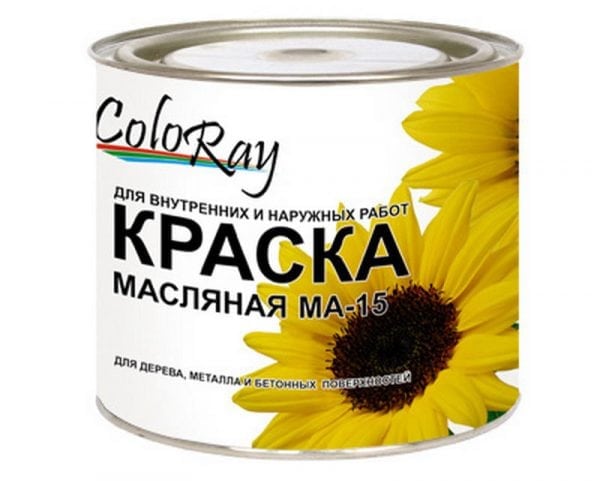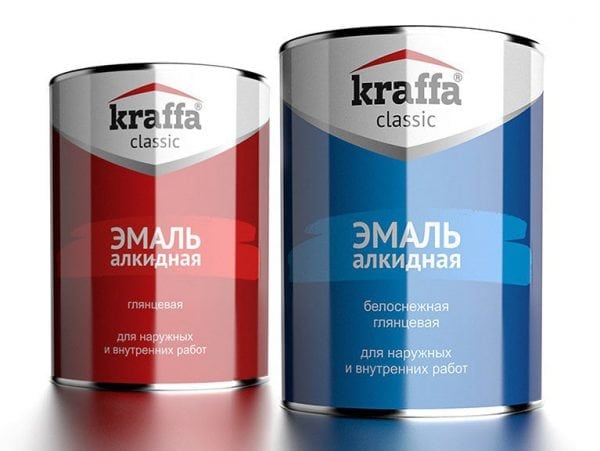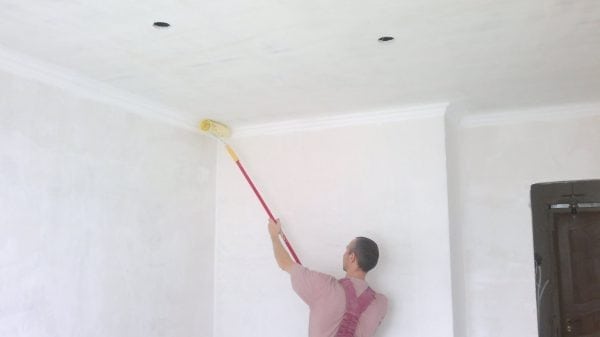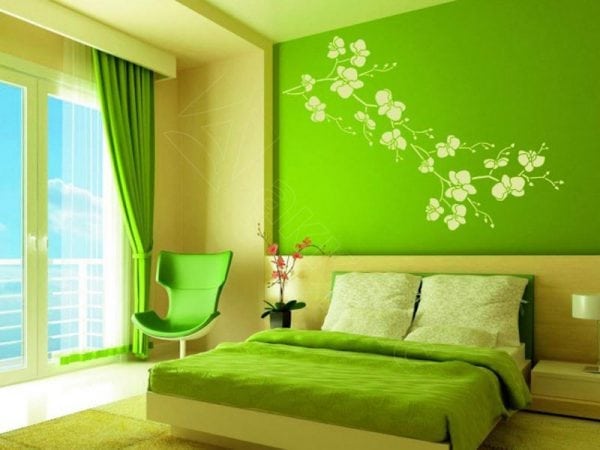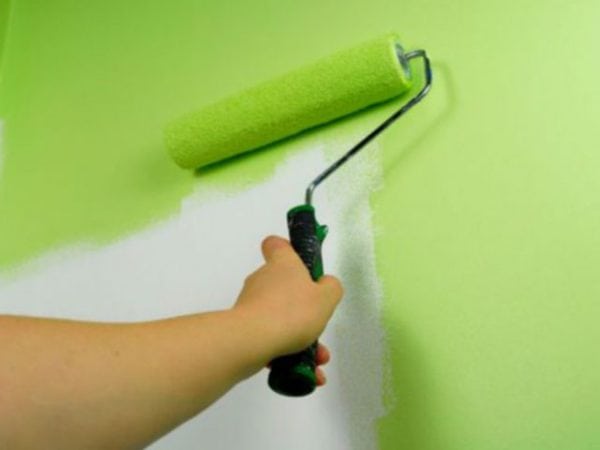The most affordable and obvious solution for finishing is drywall painting. Despite the apparent simplicity of the task, there are many nuances that need to be taken into account when performing this work.
- Benefits of painting
- Preparatory work
- Padding
- Stacking
- Finishing putty
- The choice of putty
- Paint selection
- Texture
- Colors
- Water soluble paints
- Oil paints
- Moisture resistant enamel
- Painting tools
- Calculation of paint consumption
- Painting process
- Wall painting
- Ceiling painting
- Painting in different colors
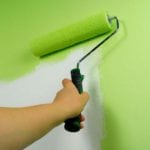
Benefits of painting
Painting gypsum plasterboard surfaces is characterized by a number of advantages:
- Financial affordability of the solution.
- The ability to do the work yourself. Painting plasterboard sheets - although responsible, but not the most difficult task.
- The ability to choose different colors in accordance with the design idea.
- The possibility of repeated repainting of the material.
Preparatory work
It is not recommended to apply paint on an unprepared surface. First, the material must be primed and putty put on it.
Preliminary preparation of drywall coating is necessary for the following reasons:
- Improving the adhesive properties of the surface.
- Increased material strength.
- Reduced ink consumption by reducing material absorption.
- Uneven drying of drywall leads to the appearance of spots after staining. This shortcoming can be corrected using an intermediate (in the form of putty) surface.
To complete the preparation, you will need the following set of materials and tools:
- primer;
- putty (start and finish);
- metal corners;
- sickle;
- sandpaper (with medium and large grains);
- roller or brush;
- spatulas;
- screwdriver;
- construction mixer.
Work is carried out in the following order:
- Inspection and elimination of installation defects.
- Primer application.
- Strengthening butt and corner parts.
- Starting puttying.
- Grout and another primer.
- Finishing putty.
- Grout with sandpaper.
- Finishing primer.
Padding
Application of a primer improves the water-repellent and adhesive qualities of drywall. It is recommended to add an antiseptic composition to the mixture to prevent mold from forming on the material.
You can choose any primer except alkyd - it is not suitable for drywall. Apply the composition with a roller or brush. It is more convenient to handle the ceiling with a roller with a telescopic handle.
to contents ↑
Stacking
The first layer of putty is designed to align relatively large surface defects. The best option for puttying is acrylic or gypsum.
First, fill in the notches near the screws, then go to the seams, then we go through the entire surface. After the starting layer has dried, we sand it with an emery cloth with medium grain. We clean the dry surface from dust and primer again.
Finishing putty
At this stage, the surface should be brought to a perfectly even state before subsequent painting. Putty is applied in a very thin layer with a narrow and wide spatula. When the surface dries, grind it with sandpaper with fine grain. Primed again.
Is it possible to paint drywall without preliminary putty, find out in this stuff.
to contents ↑The choice of putty
There are three varieties of putties:
- Cement Resistant to moisture, but shrinks and dries for a long time. This is not the best choice for drywall.
- Gypsum. Most often used for plasterboard surfaces. They are characterized by good adhesion and quick setting. The disadvantage of gypsum putties is low moisture resistance.
- Polymer. Putties on an acrylic basis are practically devoid of flaws, except for the only one - high cost.
Paint selection
There are more and less preferred paints for painting drywall. For example, the best type of paint in this case is water-soluble. An absolute contraindication is only the presence of lime in the paint material.
Texture
Drywall paint is selected taking into account the further operating conditions of the material, as well as depending on the purpose of the surface. A significant role is played by the aesthetics of the coating. As a result, the texture of paint is of particular importance:
- Glossy coatings visually increase the room. Glossy surfaces are not difficult to care for. However, the process of painting with glossy paintwork is quite laborious, since even small flaws in the work will be clearly visible.
- Matte coatings are considered preferred for ceilings. Haze masks coating defects. However, caring for such a surface is difficult.
- Semi-matt coatings are a compromise between matte and glossy surfaces. Combine the advantages and disadvantages of both options.
Colors
When choosing a color scheme, it is recommended to take into account a number of nuances:
- Poisonous shades are not the best option for the ceiling.
- Bright, large patterns look good in a large bedroom, but in a cramped corridor or small kitchen will not be appropriate.
- Due to rational color matching, a large room can be zoned.
- If you can’t find a shade in any way, choose the color in which the same walls were painted earlier, but a couple of tones are lighter.
- In the living room, bedroom and hallway, the walls should be painted darker than the ceiling. Thanks to this decision, there will be no oppressive sensation from being indoors.
- It is undesirable to use one shade for walls, floors and ceilings. However, too contrasting colors can only be used in spacious rooms.
Features of the perception of colors:
- White. The classic solution. White color is especially suitable for small rooms, as it visually expands them. Because of its versatility, this color goes well with any other.
- Blue. Gives a feeling of airiness and tenderness. Great for well-lit rooms, but not for a dark entrance hall. In dimly lit rooms it makes the atmosphere colder.
- Green. The color of harmony, energy, but also at the same time calm. Well suited to the living room and kitchen. For a bedroom it is better to choose a more tender option - olive.
- Yellow. This color enhances performance and mood, improves the activity of the nervous system. Especially suitable for children's rooms. However, too rich yellow quickly fatigue.
- Red. Increases efficiency. It goes well with white. Also, as with yellow, with a red tint you can not overdo it.
Water soluble paints
Water-dispersion and water-based paints are most often used for painting plasterboard sheets. Both types belong to the emulsion group, and the difference between them is that the water-dispersion compositions can be washed off, and they are most often white.
Such paints and varnishes are a bonding base to which pigmenting agents are added. The mixture is diluted with water. Emulsion paints are highly safe and easy to use.
Among emulsion paints, the following types should be distinguished:
- Acrylic Made from acrylic resins.
- Latex. Based on latex, which is characterized by increased strength and hydrophobicity.
- Silicate.Contain liquid glass. They are characterized by high moisture resistance.
- Silicone The main quality of silicone paints is vapor permeability and hydrophobicity.
Oil paints
Many people think that oil paints are not the best choice for drywall. However, it is not. Drywall is a very durable material that can withstand even refractory paints for metal, and oil-based paints and varnishes will not harm him even more so.
The gypsum plasterboard foundation will have to be well prepared for oil painting with paintwork materials. If for water-soluble paints it is enough just to putty the surface with a gypsum compound and apply a primer, then before applying the oil-based paint, you still need to treat the drywall with PVA glue.
The advantage of oil and enamel paints is their good hiding power, durability and quick drying. The disadvantage of such coatings is toxicity and high cost. Moreover, if in the future you try to apply some other material to the oil base, it will be very difficult to do this due to the low adhesion of the coating.
to contents ↑Moisture resistant enamel
Another type of paint that can be used when working with drywall is moisture resistant enamel coatings. A feature of enamel paints is that they form a film that is dense and resistant to external influences on the surface of the material.
In addition to the binder, enamel paints include pigment and solvent. Enamel paint dries and hardens as the solvent evaporates.
There are 2 types of enamel paints:
- Alkyd. Contain alkyd resins and are versatile.
- Pentaphthalic. Such paints include alkyd varnishes, phthalic acids and polyesters.
Painting tools
To paint drywall, the following tools and materials will be needed:
- paint;
- paint bath;
- construction mixer with nozzle;
- ladder;
- paint brushes of various widths;
- oblong nap roller or spray;
- paint tray;
- plastic film, newspaper, masking tape;
- protective equipment (glasses, gloves, respirator).
to contents ↑Note! Spray paint the fastest, but this can only be done in a well-ventilated area.
Calculation of paint consumption
The average consumption of water-based paint is 1 liter per 7–11 square meters. A liter of water dispersion paint is enough for 6-8 square meters. Oil paint will take 110–130 grams per square meter of surface.
Note! All figures are based on 1 coat of paint.
Paint consumption also depends on its color. As an example, we give the consumption of PF-115 enamel, depending on the color:
- white - from 7 to 10 square meters;
- black - from 17 to 20 square meters;
- blue or blue - from 12 to 17 square meters;
- green - from 11 to 14 square meters;
- brown - from 13 to 16 square meters;
- red or yellow - from 5 to 10 square meters.
Painting process
For painting the ceiling, water-based paints are best suited. But for walls, water-dispersion coatings based on acrylic or latex are more often chosen.
to contents ↑Wall painting
Instructions for painting walls of drywall:
- Prepare the surface for painting as described above.
- Prepare tools for work.
- Apply paint. The principle of painting depends on the type of paint material. If we are talking about the aqueous emulsion composition, you will need several very uniform and thin layers. Oil paint is applied in 3 steps: the first is a zigzag paint, the second is a dense uniform layer, the third is the finish.
If, through negligence, the paint gets outside the wall, excess can be removed with a solvent. Gypsum plasterboard dries on average 24 hours, provided that the air temperature is 20 degrees Celsius. There should be no drafts in the room, since in this case the surface will not gain the required quality.
to contents ↑Advice! If you want to give more brightness to the coating, you can apply an additional layer of paint on an already dried wall.
Ceiling painting
Sequence of execution:
- To carry out preparatory work.
- Prepare tools and materials.
- Apply paint to the ceiling. To do this, it is best to use a roller on a long handle to reach the most remote areas. A spray gun is also suitable.
- Allow the surface to dry for a day.
- If necessary, apply an additional coat of paint.
to contents ↑
Painting in different colors
Today it is fashionable to paint drywall surfaces in different colors. For example, you can create a beautiful geometric coating.
The technology of painting with different colors is quite simple:
- Draw a sketch (create patterns) on paper.
- We transfer the sketch (even schematically) to the plasterboard surface. Use a pencil or crayon.
- We glue the surface, which will not be painted immediately, with adhesive tape.
- After painting one of the sections, we are waiting for it to dry. Next, cover with masking tape and this area and continue to paint the surface.
Important! Do not paint over the area where the paint has already dried up, as in this case, unevenness and color unevenness are guaranteed.
In painting gypsum plasterboards there is nothing that would radically distinguish this work from painting any other surface. The most important thing is not to forget about the importance of the preparatory work: it is the preparation that primarily determines the quality of the finish.

